Unit 5 Poems Using Language(2) Reading and Writing 课件(20张PPT)
文档属性
| 名称 | Unit 5 Poems Using Language(2) Reading and Writing 课件(20张PPT) | 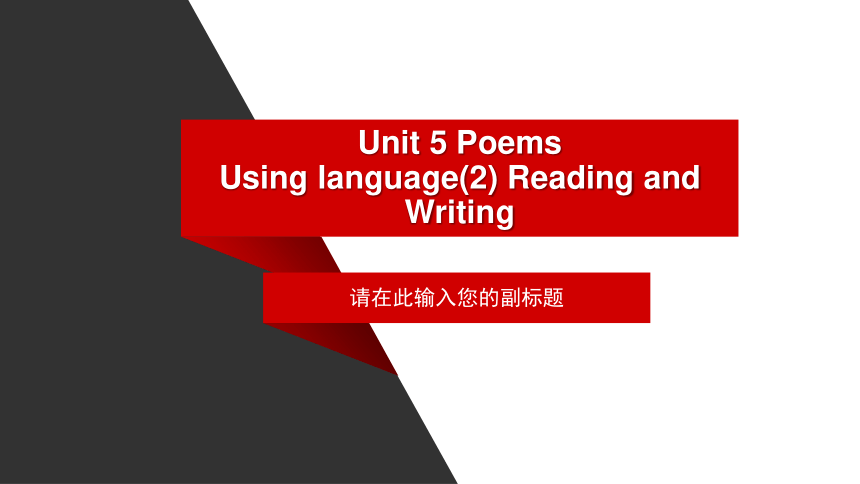 | |
| 格式 | pptx | ||
| 文件大小 | 8.6MB | ||
| 资源类型 | 试卷 | ||
| 版本资源 | 人教版(2019) | ||
| 科目 | 英语 | ||
| 更新时间 | 2024-05-06 10:02:21 | ||
图片预览

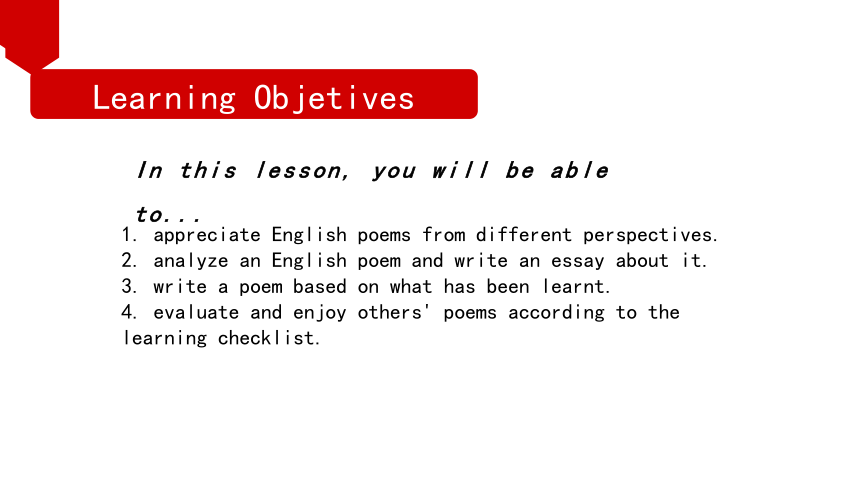
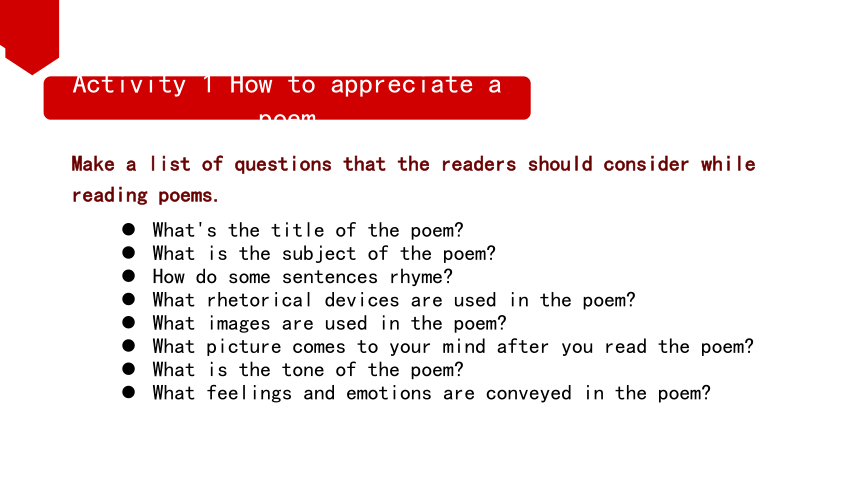
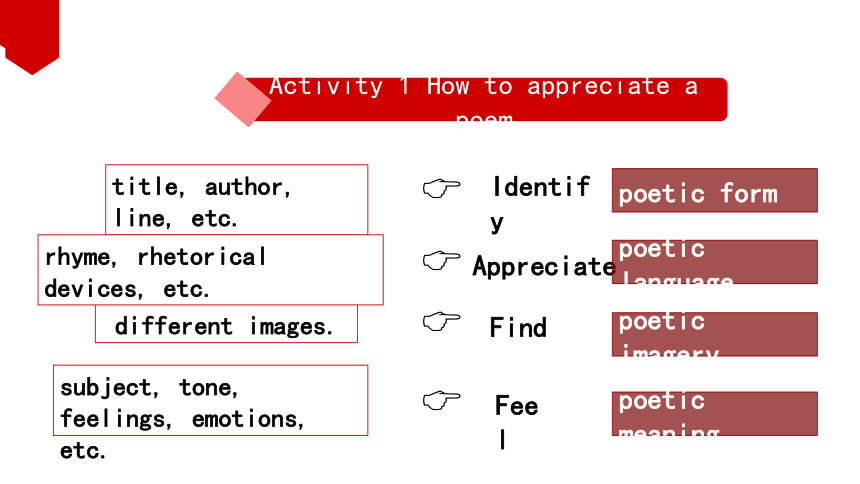
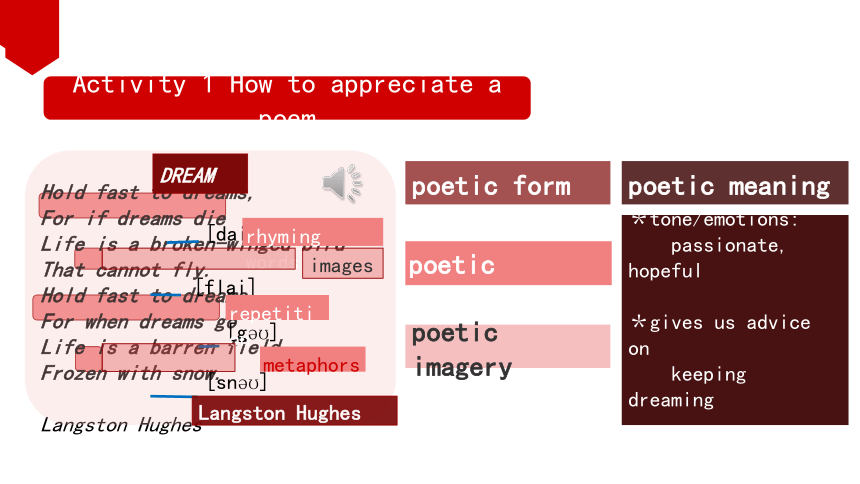
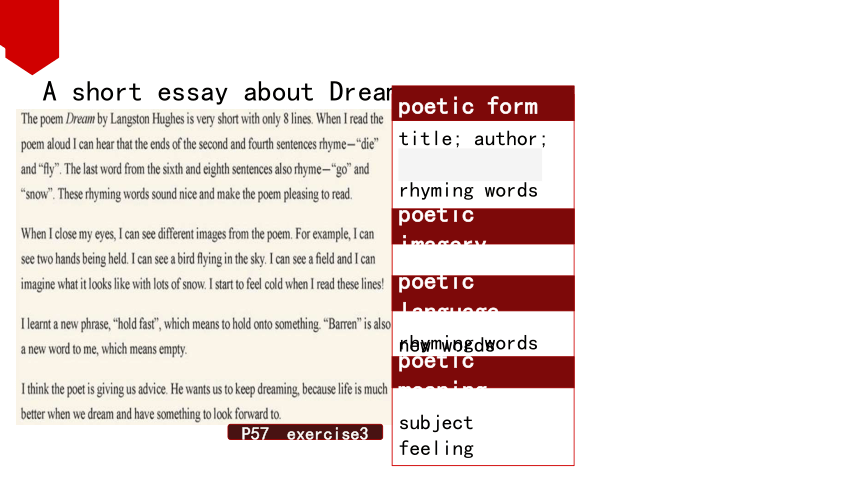
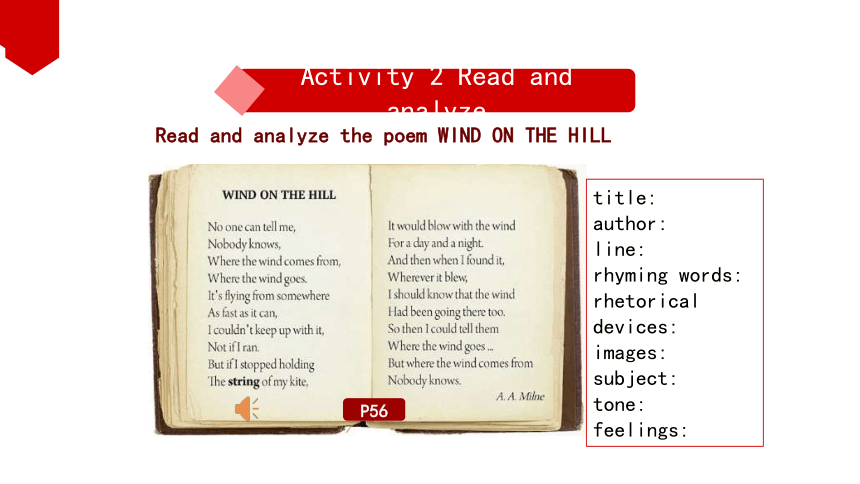
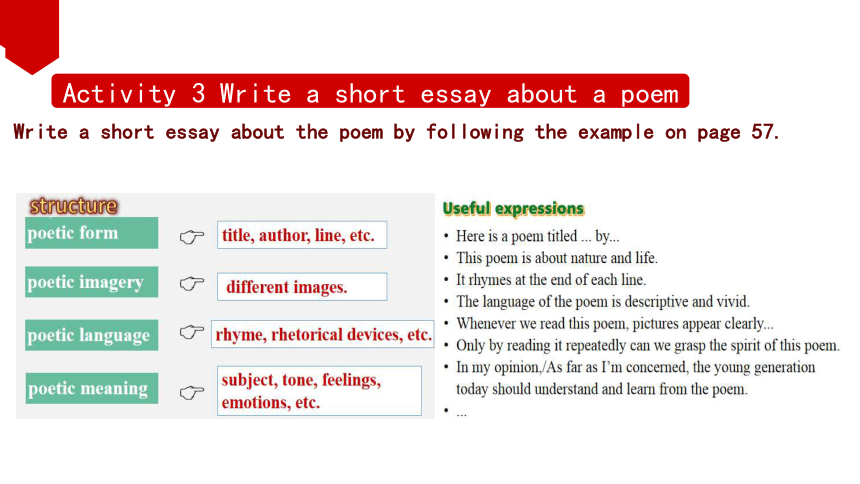
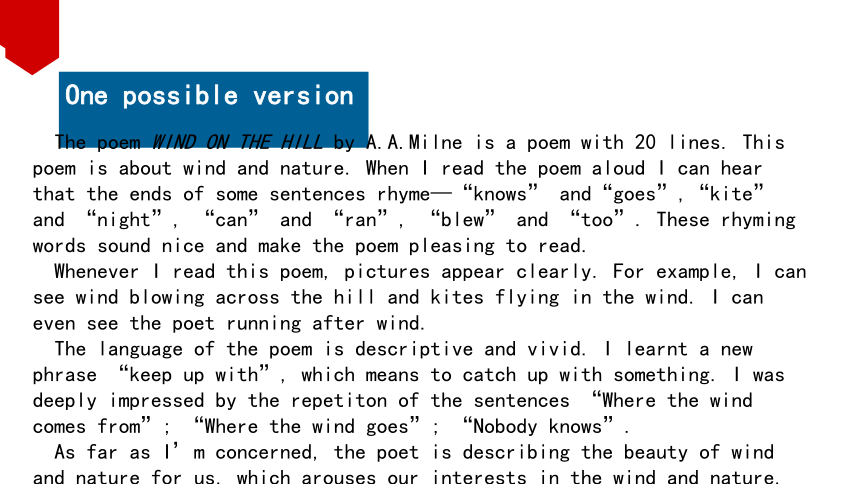
文档简介
(共20张PPT)
Unit 5 Poems
Using language(2) Reading and Writing
请在此输入您的副标题
1. appreciate English poems from different perspectives.
2. analyze an English poem and write an essay about it.
3. write a poem based on what has been learnt.
4. evaluate and enjoy others' poems according to the learning checklist.
Learning Objetives
In this lesson, you will be able to...
What's the title of the poem
What is the subject of the poem
How do some sentences rhyme
What rhetorical devices are used in the poem
What images are used in the poem
What picture comes to your mind after you read the poem
What is the tone of the poem
What feelings and emotions are conveyed in the poem
Activity 1 How to appreciate a poem
Make a list of questions that the readers should consider while reading poems.
Activity 1 How to appreciate a poem
title, author, line, etc.
different images.
rhyme, rhetorical devices, etc.
subject, tone, feelings, emotions, etc.
Identify
Find
Appreciate
Feel
poetic language
poetic imagery
poetic meaning
poetic form
DREAM
Hold fast to dreams,
For if dreams die
Life is a broken-winged bird
That cannot fly.
Hold fast to dreams,
For when dreams go
Life is a barren field
Frozen with snow.
Langston Hughes
[dai]
[flai]
[g ]
[sn ]
Activity 1 How to appreciate a poem
poetic language
rhyming words
repetition
metaphors
poetic form
DREAM
Langston Hughes
poetic imagery
poetic meaning
images
*tone/emotions:
passionate, hopeful
*gives us advice on
keeping dreaming
A short essay about Dream
P57 exercise3
title; author; lines
rhyming words
images
new words
subject
feeling
poetic form
poetic imagery
poetic language
poetic meaning
rhyming words
Activity 2 Read and analyze
Read and analyze the poem WIND ON THE HILL
P56
title:
author:
line:
rhyming words:
rhetorical devices:
images:
subject:
tone:
feelings:
Write a short essay about the poem by following the example on page 57.
Activity 3 Write a short essay about a poem
One possible version
The poem WIND ON THE HILL by A.A.Milne is a poem with 20 lines. This poem is about wind and nature. When I read the poem aloud I can hear that the ends of some sentences rhyme—“knows” and“goes”,“kite” and “night”, “can” and “ran”, “blew” and “too”. These rhyming words sound nice and make the poem pleasing to read.
Whenever I read this poem, pictures appear clearly. For example, I can see wind blowing across the hill and kites flying in the wind. I can even see the poet running after wind.
The language of the poem is descriptive and vivid. I learnt a new phrase “keep up with”, which means to catch up with something. I was deeply impressed by the repetiton of the sentences “Where the wind comes from”; “Where the wind goes”; “Nobody knows”.
As far as I’m concerned, the poet is describing the beauty of wind and nature for us, which arouses our interests in the wind and nature.
Activity 4 Write a poem
Step 1: What message do you want to give to the reader (theme, feelings, emotions)
Step 2: Make a list of words related to your theme. (rhyming words, descriptive words)
Step 3: Check how well your details paint a picture in your mind. (rhetorical devices, images)
Step 4: Read the poem aloud and listen to how it sounds. (tone/sound)
Step 5: Give it a title and your poem is ready! (title)
meaning
imagery
language
form
Step 1: What message do you want to give to the reader
Feelings/emotions:
be eager to study in SEIS again.
Theme: review experience of studying in SEIS as an exchange student.
Activity 4 Write a poem
I came here this March as an exchange student from Xinjiang University, and I will leave on July. I have gradually adapted to everything here, but I will have to say good-bye to SEIS soon. This experience is like a dream to me, and it is now also my dream to come back as a full-time student.
Step 2: Make a list of words related to your theme.
Descriptive words:
came to the north; how brave am I;
free but a little shy; time flies
Rhyming words: I; sky, by, my, goodbye
Activity 4 Write a poem
Step 3: Check how well your details paint a picture in your head.
Images: sunshine, blue sky, big city
Rhetorical devices: repetition
Picture painted:
sunshine and blue sky on March and July;
the trees alongside pass by;
a big city I never met
Activity 4 Write a poem
Step 4: Read the poem aloud and listen to how it sounds.
March, sunshine and blue sky,
came to the north, oh my!
'Cause I never realize,
How brave am I!
Watching the trees alongside pass by,
free but a little shy.
It's a big city I never met,
to everyone here, I need to adapt.
Time flies before I realize.
July, still sunshine and blue sky,
It's time to say goodbye.
To me, it was a dream.
To me, it is a dream.
Step 5: Give it a title and your poem is ready!
I Have a Dream
Create your own poem by following steps below.
Activity 4Write a poem
poetic meaning
poetic language
poetic imagery
poetic form
One possible version
Activity 5 Evaluate and enjoy others' poems
Checklist
Is the theme/subject of the poem clear
Does the poem rhyme
Are there any rhetorical devices in the poem
Are the words and phrases related to the theme
Are there any images in the poem
Does the poem paint a picture in your mind
Are feelings and emotions clearly conveyed
Does the poem have a proper title
poetic meaning
poetic language
poetic imagery
poetic form
Activity 5 Evaluate and enjoy others' poems
Checklist
clear theme/subject
rhyming word
rhetorical devices
theme-related words
images
a picture in your mind
feelings and emotions
proper title
√
√
√
√
√
√
√
√
Assignment
1. Work in groups, evaluate and enjoy others' poems according to the learning checklist and polish your poems based on others' advice.
2. Write a short essay about the poem A MATCH on page 56.
Thank you
Unit 5 Poems
Using language(2) Reading and Writing
请在此输入您的副标题
1. appreciate English poems from different perspectives.
2. analyze an English poem and write an essay about it.
3. write a poem based on what has been learnt.
4. evaluate and enjoy others' poems according to the learning checklist.
Learning Objetives
In this lesson, you will be able to...
What's the title of the poem
What is the subject of the poem
How do some sentences rhyme
What rhetorical devices are used in the poem
What images are used in the poem
What picture comes to your mind after you read the poem
What is the tone of the poem
What feelings and emotions are conveyed in the poem
Activity 1 How to appreciate a poem
Make a list of questions that the readers should consider while reading poems.
Activity 1 How to appreciate a poem
title, author, line, etc.
different images.
rhyme, rhetorical devices, etc.
subject, tone, feelings, emotions, etc.
Identify
Find
Appreciate
Feel
poetic language
poetic imagery
poetic meaning
poetic form
DREAM
Hold fast to dreams,
For if dreams die
Life is a broken-winged bird
That cannot fly.
Hold fast to dreams,
For when dreams go
Life is a barren field
Frozen with snow.
Langston Hughes
[dai]
[flai]
[g ]
[sn ]
Activity 1 How to appreciate a poem
poetic language
rhyming words
repetition
metaphors
poetic form
DREAM
Langston Hughes
poetic imagery
poetic meaning
images
*tone/emotions:
passionate, hopeful
*gives us advice on
keeping dreaming
A short essay about Dream
P57 exercise3
title; author; lines
rhyming words
images
new words
subject
feeling
poetic form
poetic imagery
poetic language
poetic meaning
rhyming words
Activity 2 Read and analyze
Read and analyze the poem WIND ON THE HILL
P56
title:
author:
line:
rhyming words:
rhetorical devices:
images:
subject:
tone:
feelings:
Write a short essay about the poem by following the example on page 57.
Activity 3 Write a short essay about a poem
One possible version
The poem WIND ON THE HILL by A.A.Milne is a poem with 20 lines. This poem is about wind and nature. When I read the poem aloud I can hear that the ends of some sentences rhyme—“knows” and“goes”,“kite” and “night”, “can” and “ran”, “blew” and “too”. These rhyming words sound nice and make the poem pleasing to read.
Whenever I read this poem, pictures appear clearly. For example, I can see wind blowing across the hill and kites flying in the wind. I can even see the poet running after wind.
The language of the poem is descriptive and vivid. I learnt a new phrase “keep up with”, which means to catch up with something. I was deeply impressed by the repetiton of the sentences “Where the wind comes from”; “Where the wind goes”; “Nobody knows”.
As far as I’m concerned, the poet is describing the beauty of wind and nature for us, which arouses our interests in the wind and nature.
Activity 4 Write a poem
Step 1: What message do you want to give to the reader (theme, feelings, emotions)
Step 2: Make a list of words related to your theme. (rhyming words, descriptive words)
Step 3: Check how well your details paint a picture in your mind. (rhetorical devices, images)
Step 4: Read the poem aloud and listen to how it sounds. (tone/sound)
Step 5: Give it a title and your poem is ready! (title)
meaning
imagery
language
form
Step 1: What message do you want to give to the reader
Feelings/emotions:
be eager to study in SEIS again.
Theme: review experience of studying in SEIS as an exchange student.
Activity 4 Write a poem
I came here this March as an exchange student from Xinjiang University, and I will leave on July. I have gradually adapted to everything here, but I will have to say good-bye to SEIS soon. This experience is like a dream to me, and it is now also my dream to come back as a full-time student.
Step 2: Make a list of words related to your theme.
Descriptive words:
came to the north; how brave am I;
free but a little shy; time flies
Rhyming words: I; sky, by, my, goodbye
Activity 4 Write a poem
Step 3: Check how well your details paint a picture in your head.
Images: sunshine, blue sky, big city
Rhetorical devices: repetition
Picture painted:
sunshine and blue sky on March and July;
the trees alongside pass by;
a big city I never met
Activity 4 Write a poem
Step 4: Read the poem aloud and listen to how it sounds.
March, sunshine and blue sky,
came to the north, oh my!
'Cause I never realize,
How brave am I!
Watching the trees alongside pass by,
free but a little shy.
It's a big city I never met,
to everyone here, I need to adapt.
Time flies before I realize.
July, still sunshine and blue sky,
It's time to say goodbye.
To me, it was a dream.
To me, it is a dream.
Step 5: Give it a title and your poem is ready!
I Have a Dream
Create your own poem by following steps below.
Activity 4Write a poem
poetic meaning
poetic language
poetic imagery
poetic form
One possible version
Activity 5 Evaluate and enjoy others' poems
Checklist
Is the theme/subject of the poem clear
Does the poem rhyme
Are there any rhetorical devices in the poem
Are the words and phrases related to the theme
Are there any images in the poem
Does the poem paint a picture in your mind
Are feelings and emotions clearly conveyed
Does the poem have a proper title
poetic meaning
poetic language
poetic imagery
poetic form
Activity 5 Evaluate and enjoy others' poems
Checklist
clear theme/subject
rhyming word
rhetorical devices
theme-related words
images
a picture in your mind
feelings and emotions
proper title
√
√
√
√
√
√
√
√
Assignment
1. Work in groups, evaluate and enjoy others' poems according to the learning checklist and polish your poems based on others' advice.
2. Write a short essay about the poem A MATCH on page 56.
Thank you
